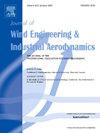Aeroelastic simulation of torsional vibrations in a single-axis solar tracker
IF 4.9
2区 工程技术
Q1 ENGINEERING, CIVIL
Journal of Wind Engineering and Industrial Aerodynamics
Pub Date : 2025-07-28
DOI:10.1016/j.jweia.2025.106190
引用次数: 0
Abstract
Wind-induced torsional vibrations in a single-axis solar tracker (SAST) are simulated by coupling a structural displacement solver with delayed-detached eddy simulation (DDES) of the turbulent crossflow. The resulting amplitude-frequency response is reported across an operational range of reduced wind velocities at various orientations. This investigation aims to offer a cost-effective, agile alternative to wind-tunnel testing for SAST development. Based on validated fluid-elastic modeling practices, the work focuses on predicting the torsional galloping instability, as observed in earlier experimental research. The solutions confirm the onset of torsional instability for certain SAST orientations at critical reduced velocities in agreement with peer measurements. Moreover, two markedly different aeroelastic behaviours are categorized, labelled as the vortex-asynchronous and vortex-synchronous vibration regimes. Spectral analysis reveals that self-excited vibration is triggered by synchronization between the frequencies of vortex shedding and torsional vibration. The normalized work performed on the structure is computed, demonstrating a net energy influx per cycle from flow to structure during the galloping phenomenon. Ultimately, the adopted methodology serves as a viable and inexpensive test bed for the expedite prediction of aeroelastic response in SASTs. The automated control of design parameters and rapid computational turnaround can significantly streamline the wind design of open solar structures.
单轴太阳跟踪器扭转振动的气动弹性模拟
采用结构位移求解器与延迟分离涡流模拟(DDES)相结合的方法,模拟了单轴太阳跟踪器(SAST)的风致扭转振动。由此产生的幅频响应报告了在不同方向上降低风速的操作范围。这项研究旨在为SAST开发提供一种经济、灵活的替代风洞测试的方法。基于验证的流体弹性建模实践,工作重点是预测扭转奔驰不稳定性,正如在早期的实验研究中观察到的那样。这些解决方案证实了某些SAST方向在临界减速下的扭转不稳定的开始,与同行测量结果一致。此外,还将两种明显不同的气动弹性行为分类为涡旋-异步和涡旋-同步振动。频谱分析表明,自激振动是由旋涡脱落频率和扭转振动频率同步触发的。计算了对结构进行的归一化功,证明了在振荡现象期间,每个循环从流体到结构的净能量流入。最终,所采用的方法可作为快速预测ssts气动弹性响应的可行且廉价的试验台。设计参数的自动化控制和快速的计算周转可以大大简化开放式太阳能结构的风设计。
本文章由计算机程序翻译,如有差异,请以英文原文为准。
求助全文
约1分钟内获得全文
求助全文
来源期刊
CiteScore
8.90
自引率
22.90%
发文量
306
审稿时长
4.4 months
期刊介绍:
The objective of the journal is to provide a means for the publication and interchange of information, on an international basis, on all those aspects of wind engineering that are included in the activities of the International Association for Wind Engineering http://www.iawe.org/. These are: social and economic impact of wind effects; wind characteristics and structure, local wind environments, wind loads and structural response, diffusion, pollutant dispersion and matter transport, wind effects on building heat loss and ventilation, wind effects on transport systems, aerodynamic aspects of wind energy generation, and codification of wind effects.
Papers on these subjects describing full-scale measurements, wind-tunnel simulation studies, computational or theoretical methods are published, as well as papers dealing with the development of techniques and apparatus for wind engineering experiments.

 求助内容:
求助内容: 应助结果提醒方式:
应助结果提醒方式:


